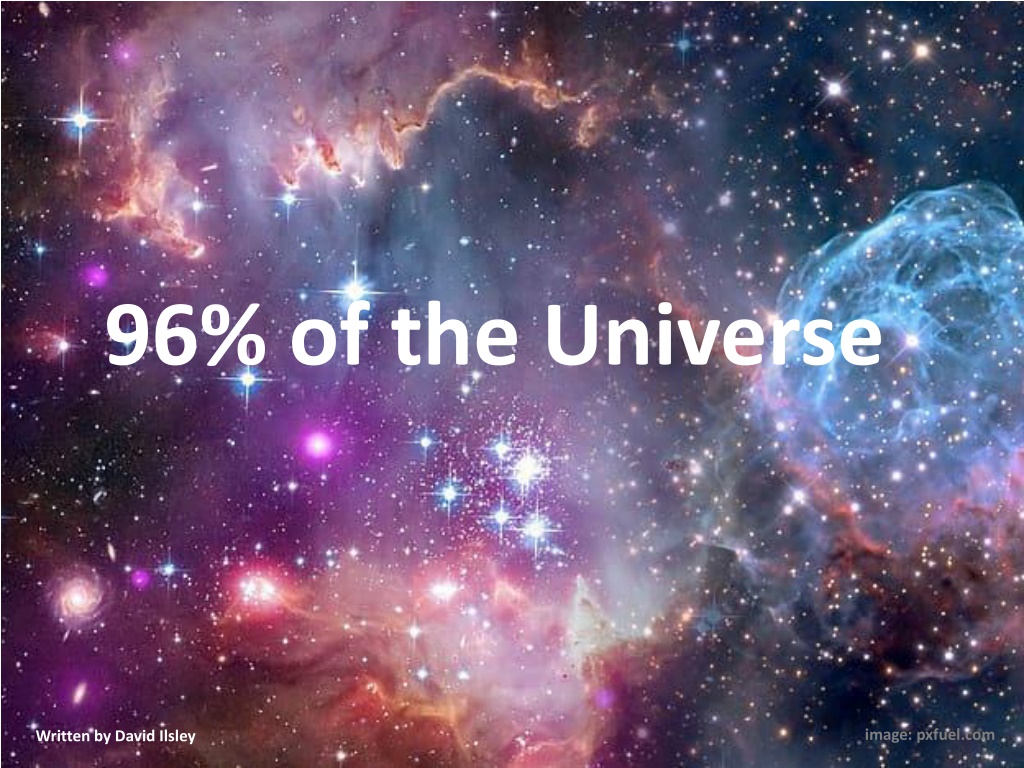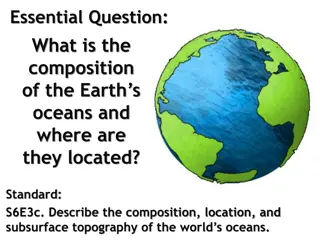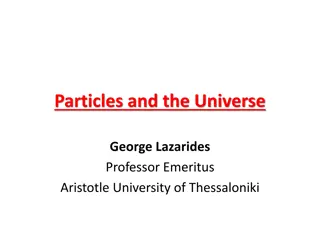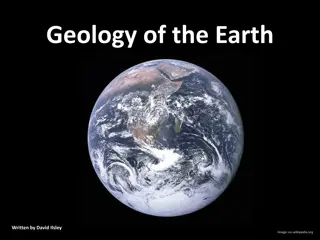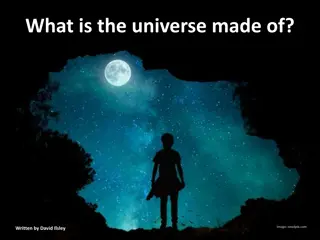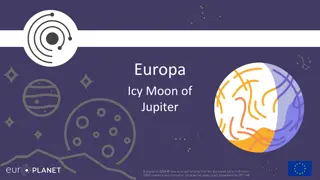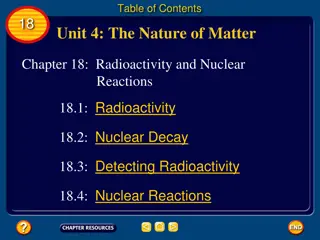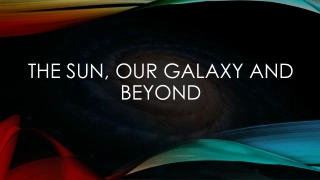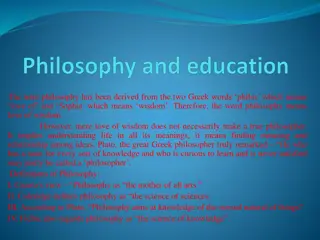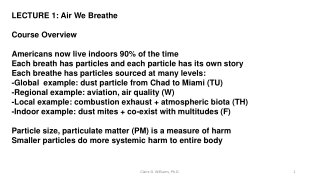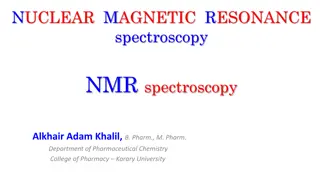Exploring the Composition of the Universe
The universe is a vast expanse consisting of various components. Only 0.4% comprises galaxies, while hydrogen, helium, protons, neutrons, and electrons make up 4%. The remaining 96% includes photons, neutrinos, dark matter, and dark energy. Photons, fundamental particles of light, exhibit different wavelengths, creating the spectrum of colors we see in light. Understanding these elements sheds light on the intricate composition of the cosmos.
Download Presentation
Please find below an Image/Link to download the presentation.
The content on the website is provided AS IS for your information and personal use only. It may not be sold, licensed, or shared on other websites without obtaining consent from the author. Download presentation by click this link. If you encounter any issues during the download, it is possible that the publisher has removed the file from their server.
Presentation Transcript
96% of the Universe image: pxfuel.com Written by David Ilsley
The observable universe contains about 100 billion galaxies. Each galaxy contains about 100 billion stars, plus a bit of extra gas and dust and some planets etc. image: commons.wikimedia.org
But these galaxies make up only 0.4% of the universe. Another 3.6% is hydrogen and helium gas between the galaxies. Just 4% of the universe is made of protons, neutrons and electrons. image: commons.wikimedia.org
What is the other 96%? It is about: 0.01% photons 0.6% neutrinos 22% dark matter 73% dark energy
Photons image: commons.wikimedia.org
Just like matter, light is made of particles. They are called photons. One photon is a very small amount of light: a candle produces about 1024 (a trillion trillion) photons per second. image: commons.wikimedia.org
The Sun produces about 1045 photons per second. Most of these don t hit anything they keep travelling across the universe for ever. Space is full of photons from stars. If it wasn t, we wouldn t be able to see the stars.
Unlike protons, neutrons and electrons, though, photons aren t all the same. Photons can be thought of as waves. The waves have different wavelengths. image: commons.wikimedia.org
Red light photons have a long wavelength about 700 nm Orange light photons have a wavelength about 610 nm Yellow light about 580 nm Green light about 520 nm Blue light about 440 nm Violet light about 400 nm
White light from the Sun is a mixture of these colours. When we shine white light through a prism or through rain drops, it gets split up into the separate colours. image: commons.wikimedia.org
Light is a type of electromagnetic radiation. Electromagnetic radiation ranges in wavelength from kilometres down to trillionths of a centimetre. Our eyes are sensitive to only a tiny part of this spectrum. image: commons.wikimedia.org
As well as visible light, the universe is full of photons of all types of electromagnetic radiation. The universe contains about 1090 photons about a billion per cubic metre on average.
The number of protons in the universe is only about 1080. So there are about a billion times as many photons as protons. But, because photons weigh far far less than protons, photons make up only about 0.01% of the mass of the universe.
Neutrinos image: spektrum.de
Neutrinos are very small particles with very little mass. They travel close to the speed of light. There are about as many neutrinos in the universe as there are photons about a billion per cubic metre.
Neutrinos are produced in nuclear reactions like those going on inside stars. Unlike photons, neutrinos don t generally interact with other particles, except through the gravitational force. So most pass straight through things like humans and the Earth without touching them. About a thousand trillion neutrinos pass through your body every second.
Neutrinos are heavier than photons and make up about 0.6% of the mass of the universe. Protons, neutrons, electrons, photons and neutrinos together still make up only about 5% of the universe.
Dark Matter Dark matter makes up about 23% of the mass of the universe. about 6 times as much as light matter.
We cant see dark matter. It doesn t even look dark. So how do we know it s there? It was discovered when it was noticed that the way galaxies rotate can t be explained in terms of the amount and distribution of stars, gas and dust in the galaxies.
The rotation pattern required the presence of a large spherical blob of stuff around the galaxy with about 6 times the mass of the light matter in the galaxy. This discovery was made in the 1970s. The idea of dark matter wasn t taken very seriously at first, but since then, a lot of evidence supporting it has been collected. image: commons.wikimedia.org
There are two main theories for what dark matter is made of. The first is that it is made of WIMPs The second is that it is made of MACHOs image: commons.wikimedia.org image: pixabay.com
WIMPs are weakly interacting massive particles. These are particles similar in size and mass to protons. They exert a gravitational force, but none of the other three forces. They would be a type of particle we have never observed on Earth.
MACHOs are massive compact halo objects. These are objects like brown dwarfs, planets, black holes etc. which orbit the galaxy in its halo, but which are too dim to see from Earth. image: commons.wikimedia.org
While there are known to be MACHOs around galaxies, the evidence strongly suggests that there are nowhere near enough to explain the rotation patterns. So most astronomers prefer the WIMP model. image: commons.wikimedia.org
Dark Energy Dark Energy makes up the remaining 73% of the universe. Like dark matter, we don t really understand it.
There are two main lines of evidence for the existence of dark energy. The first is that, even with dark matter, there is only about a quarter of the mass in the universe that is required to produce the observed flatness of space. The second is that the expansion of the universe is accelerating. Without dark energy, gravity would cause the expansion of the universe to slow down.
Dark energy seems to be distributed evenly through the universe. In fact, rather than being something distributed through space, it can be thought of as a property of space itself.
We tend to think of space as just nothing. But it s not. It s something. It s just not anything that we can see or feel. Space has mass About 10 23 g/m3 or 1019 t/ly3 Space was created in the big bang Before the big bang there was no space Space is constantly expanding The expansion of the universe isn t caused by the galaxies zooming out into empty space. Instead, space itself expands, taking the galaxies and everything else with it. Space is warped by heavy objects
In fact, it may be better to think that 73% of the universe is Space and that space, by its very nature, has dark energy.
